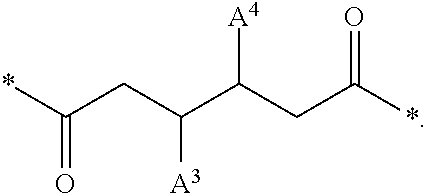Magnetic recording medium composition and method of manufacturing magnetic recording medium
a technology of magnetic recording medium and composition, which is applied in the direction of data recording, inorganic material magnetism, magnetic bodies, etc., can solve the problems of reducing the durability of the magnetic layer, reducing and compromising the dispersion of the ferromagnetic powder. , to achieve the effect of enhancing the dispersion, enhancing the dispersion, and enhancing the dispersion
- Summary
- Abstract
- Description
- Claims
- Application Information
AI Technical Summary
Benefits of technology
Problems solved by technology
Method used
Image
Examples
synthesis example 1
Synthesis of Precursor 1
[0215]To a 500 mL three-necked flask were charged 197.2 g of ε-caprolactone and 11.3 g of furfuryl alcohol. While blowing in nitrogen, the mixture was stirred and dissolved at an internal temperature of 80° C. A 0.1 g quantity of monobutyltin oxide was added to the flask and the internal temperature was raised by heating to 100° C. After 8 hours, the disappearance of the starting materials was confirmed by gas chromatography, after which the contents were cooled to room temperature, yielding 200 g of Precursor 1 (with the structure indicated below) in the form of a solid.
synthesis example 2
Synthesis of Precursor 2
[0216]To a 500 mL three-necked flask were charged 197.2 g of ε-caprolactone and 16.3 g of N-(2-hydroxyethyl)maleimide. While blowing in nitrogen, the mixture was stirred and dissolved at an internal temperature of 80° C. A 0.1 g quantity of monobutyltin oxide was added to the flask and the internal temperature was raised by heating to 100° C. After 8 hours, the disappearance of the starting materials was confirmed by gas chromatography, after which the contents were cooled to room temperature, yielding 200 g of Precursor 2 (with the structure indicated below) in the form of a solid.
synthesis example 3
Synthesis of Precursor 3
[0217]To a 500 mL three-necked flask were charged 197.2 g of ε-caprolactone and 13.4 g of 2-hydroxyethyl acrylate. While blowing in nitrogen, the mixture was stirred and dissolved at an internal temperature of 80° C. A 0.1 g quantity of monobutyltin oxide was added to the flask and the internal temperature was raised by heating to 100° C. After 8 hours, the disappearance of the starting materials was confirmed by gas chromatography, after which the contents were cooled to room temperature, yielding 200 g of Precursor 3 (with the structure indicated below) in the form of a solid.
PUM
| Property | Measurement | Unit |
|---|---|---|
| particle size | aaaaa | aaaaa |
| inner diameter | aaaaa | aaaaa |
| boiling point | aaaaa | aaaaa |
Abstract
Description
Claims
Application Information
 Login to View More
Login to View More - R&D
- Intellectual Property
- Life Sciences
- Materials
- Tech Scout
- Unparalleled Data Quality
- Higher Quality Content
- 60% Fewer Hallucinations
Browse by: Latest US Patents, China's latest patents, Technical Efficacy Thesaurus, Application Domain, Technology Topic, Popular Technical Reports.
© 2025 PatSnap. All rights reserved.Legal|Privacy policy|Modern Slavery Act Transparency Statement|Sitemap|About US| Contact US: help@patsnap.com



